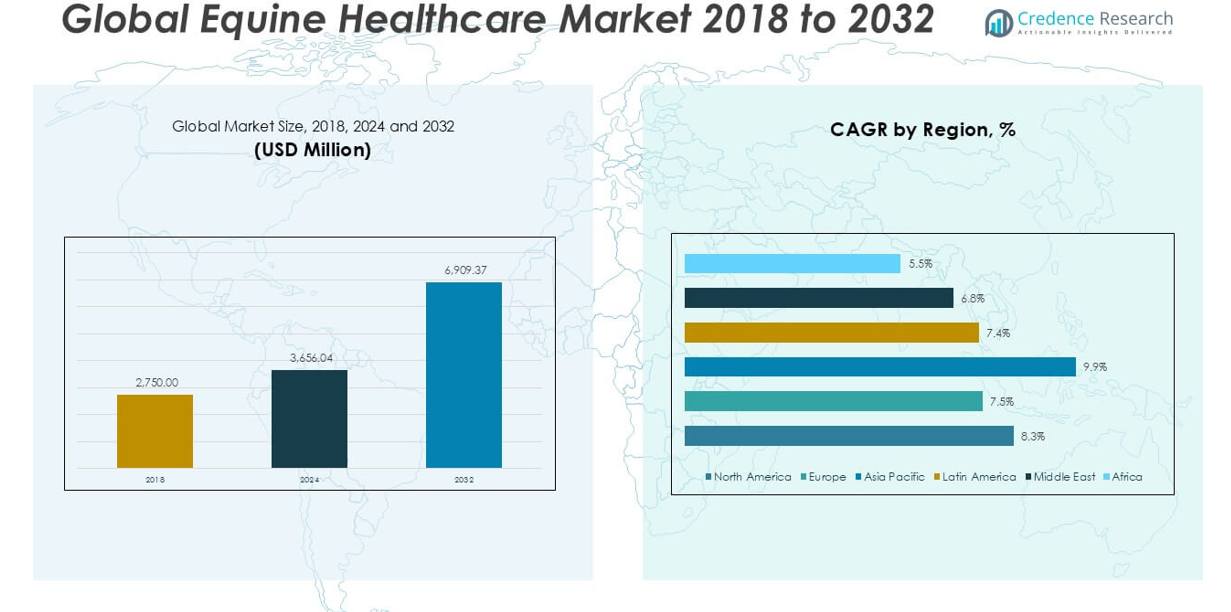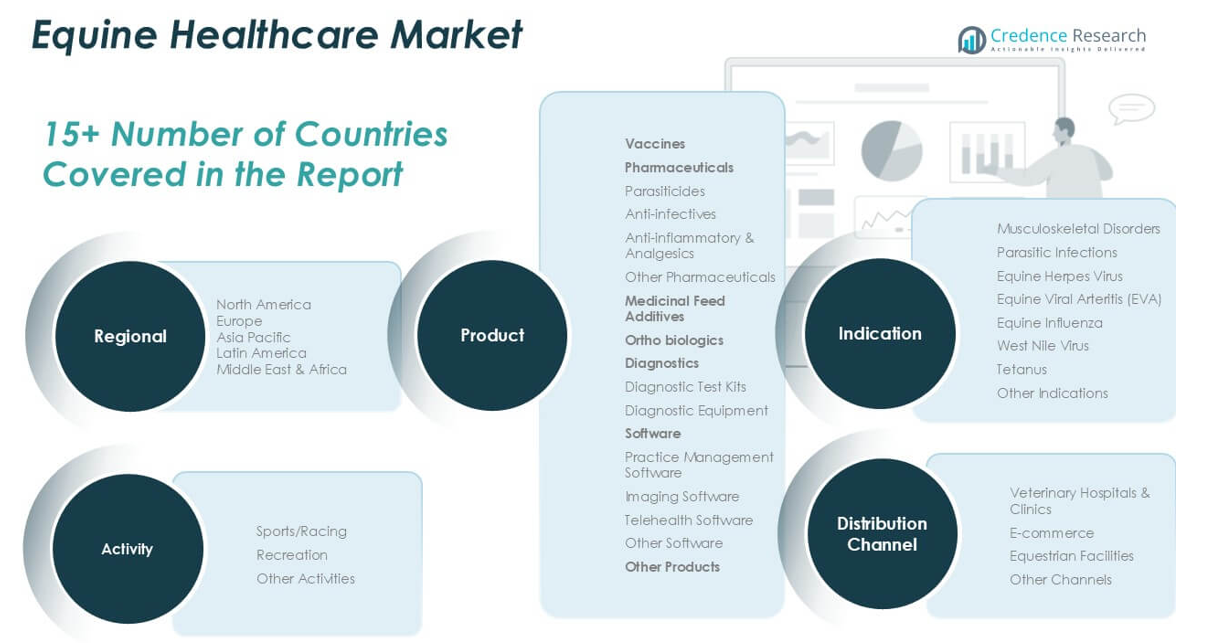CHAPTER NO. 1 : GENESIS OF THE MARKET
1.1 Market Prelude – Introduction & Scope
1.2 The Big Picture – Objectives & Vision
1.3 Strategic Edge – Unique Value Proposition
1.4 Stakeholder Compass – Key Beneficiaries
CHAPTER NO. 2 : EXECUTIVE LENS
2.1 Pulse of the Industry – Market Snapshot
2.2 Growth Arc – Revenue Projections (USD Million)
2.3. Premium Insights – Based on Primary Interviews
CHAPTER NO. 3 : EQUINE HEALTHCARE MARKET FORCES & INDUSTRY PULSE
3.1 Foundations of Change – Market Overview
3.2 Catalysts of Expansion – Key Market Drivers
3.2.1 Momentum Boosters – Growth Triggers
3.2.2 Innovation Fuel – Disruptive Technologies
3.3 Headwinds & Crosswinds – Market Restraints
3.3.1 Regulatory Tides – Compliance Challenges
3.3.2 Economic Frictions – Inflationary Pressures
3.4 Untapped Horizons – Growth Potential & Opportunities
3.5 Strategic Navigation – Industry Frameworks
3.5.1 Market Equilibrium – Porter’s Five Forces
3.5.2 Ecosystem Dynamics – Value Chain Analysis
3.5.3 Macro Forces – PESTEL Breakdown
3.6 Price Trend Analysis
3.6.1 Regional Price Trend
3.6.2 Price Trend by product
CHAPTER NO. 4 : KEY INVESTMENT EPICENTER
4.1 Regional Goldmines – High-Growth Geographies
4.2 Product Frontiers – Lucrative Product Categories
4.3 Indication Sweet Spots – Emerging Demand Segments
CHAPTER NO. 5: REVENUE TRAJECTORY & WEALTH MAPPING
5.1 Momentum Metrics – Forecast & Growth Curves
5.2 Regional Revenue Footprint – Market Share Insights
5.3 Segmental Wealth Flow – Product & Indication Revenue
CHAPTER NO. 6 : TRADE & COMMERCE ANALYSIS
6.1. Import Analysis by Region
6.1.1. Global Equine Healthcare Market Import Revenue By Region
6.2. Export Analysis by Region
6.2.1. Global Equine Healthcare Market Export Revenue By Region
CHAPTER NO. 7 : COMPETITION ANALYSIS
7.1. Company Market Share Analysis
7.1.1. Global Equine Healthcare Market: Company Market Share
7.2. Global Equine Healthcare Market Company Revenue Market Share
7.3. Strategic Developments
7.3.1. Acquisitions & Mergers
7.3.2. New Product Launch
7.3.3. Regional Expansion
7.4. Competitive Dashboard
7.5. Company Assessment Metrics, 2024
CHAPTER NO. 8 : EQUINE HEALTHCARE MARKET – BY PRODUCT SEGMENT ANALYSIS
8.1. Equine Healthcare Market Overview by Product Segment
8.1.1. Equine Healthcare Market Revenue Share By Product
8.2. Vaccines
8.3. Pharmaceuticals
8.3.1 Parasiticides
8.3.2 Anti-infectives
8.3.3 Anti-inflammatory & Analgesics
8.3.4 Other Pharmaceuticals
8.4. Medicinal Feed Additives
8.5. Ortho biologics
8.6. Diagnostics
8.6.1 Diagnostic Test Kits
8.6.2 Diagnostic Equipment
8.7. Software
8.7.1 Practice Management Software
8.7.2 Imaging Software
8.7.3 Telehealth Software
8.7.4 Other Software
8.8. Other Products
CHAPTER NO. 9 : EQUINE HEALTHCARE MARKET – BY INDICATION SEGMENT ANALYSIS
9.1. Equine Healthcare Market Overview by Indication Segment
9.1.1. Equine Healthcare Market Revenue Share By Indication
9.2. Musculoskeletal Disorders
9.3. Parasitic Infections
9.4. Equine Herpes Virus
9.5. Equine Viral Arteritis (EVA)
9.6. Equine Influenza
9.7. West Nile Virus
9.8. Tetanus
9.9. Other Indications
CHAPTER NO. 10 : EQUINE HEALTHCARE MARKET – BY ACTIVITY SEGMENT ANALYSIS
10.1. Equine Healthcare Market Overview by Activity Segment
10.1.1. Equine Healthcare Market Revenue Share By Activity
10.2. Sports/Racing
10.3. Recreation
10.4. Other Activities
CHAPTER NO. 11 : EQUINE HEALTHCARE MARKET – BY DISTRIBUTION CHANNEL SEGMENT ANALYSIS
11.1. Equine Healthcare Market Overview by Distribution Channel Segment
11.1.1. Equine Healthcare Market Revenue Share By Distribution Channel
11.2. Veterinary Hospitals & Clinics
11.3. E-commerce
11.4. Equestrian Facilities
11.5. Others
CHAPTER NO. 12 : EQUINE HEALTHCARE MARKET – REGIONAL ANALYSIS
12.1. Equine Healthcare Market Overview by Region Segment
12.1.1. Global Equine Healthcare Market Revenue Share By Region
12.1.2. Regions
12.1.3. Global Equine Healthcare Market Revenue By Region
12.1.4. Product
12.1.5. Global Equine Healthcare Market Revenue By Product
12.1.6. Indication
12.1.7. Global Equine Healthcare Market Revenue By Indication
12.1.8. Activity
12.1.9. Global Equine Healthcare Market Revenue By Activity
12.1.10. Distribution Channel
12.1.11. Global Equine Healthcare Market Revenue By Distribution Channel
CHAPTER NO. 13 : NORTH AMERICA EQUINE HEALTHCARE MARKET – COUNTRY ANALYSIS
13.1. North America Equine Healthcare Market Overview by Country Segment
13.1.1. North America Equine Healthcare Market Revenue Share By Region
13.2. North America
13.2.1. North America Equine Healthcare Market Revenue By Country
13.2.2. Product
13.2.3. North America Equine Healthcare Market Revenue By Product
13.2.4. Indication
13.2.5. North America Equine Healthcare Market Revenue By Indication
13.2.6. Activity
13.2.7. North America Equine Healthcare Market Revenue By Activity
13.2.8. Distribution Channel
13.2.9. North America Equine Healthcare Market Revenue By Distribution Channel
13.3. U.S.
13.4. Canada
13.5. Mexico
CHAPTER NO. 14 : EUROPE EQUINE HEALTHCARE MARKET – COUNTRY ANALYSIS
14.1. Europe Equine Healthcare Market Overview by Country Segment
14.1.1. Europe Equine Healthcare Market Revenue Share By Region
14.2. Europe
14.2.1. Europe Equine Healthcare Market Revenue By Country
14.2.2. Product
14.2.3. Europe Equine Healthcare Market Revenue By Product
14.2.4. Indication
14.2.5. Europe Equine Healthcare Market Revenue By Indication
14.2.6. Activity
14.2.7. Europe Equine Healthcare Market Revenue By Activity
14.2.8. Distribution Channel
14.2.9. Europe Equine Healthcare Market Revenue By Distribution Channel
14.3. UK
14.4. France
14.5. Germany
14.6. Italy
14.7. Spain
14.8. Russia
14.9. Rest of Europe
CHAPTER NO. 15 : ASIA PACIFIC EQUINE HEALTHCARE MARKET – COUNTRY ANALYSIS
15.1. Asia Pacific Equine Healthcare Market Overview by Country Segment
15.1.1. Asia Pacific Equine Healthcare Market Revenue Share By Region
15.2. Asia Pacific
15.2.1. Asia Pacific Equine Healthcare Market Revenue By Country
15.2.2. Product
15.2.3. Asia Pacific Equine Healthcare Market Revenue By Product
15.2.4. Indication
15.2.5. Asia Pacific Equine Healthcare Market Revenue By Indication
15.2.6. Activity
15.2.7. Asia Pacific Equine Healthcare Market Revenue By Activity
15.2.8. Distribution Channel
15.2.9. Asia Pacific Equine Healthcare Market Revenue By Distribution Channel
15.3. China
15.4. Japan
15.5. South Korea
15.6. India
15.7. Australia
15.8. Southeast Asia
15.9. Rest of Asia Pacific
CHAPTER NO. 16 : LATIN AMERICA EQUINE HEALTHCARE MARKET – COUNTRY ANALYSIS
16.1. Latin America Equine Healthcare Market Overview by Country Segment
16.1.1. Latin America Equine Healthcare Market Revenue Share By Region
16.2. Latin America
16.2.1. Latin America Equine Healthcare Market Revenue By Country
16.2.2. Product
16.2.3. Latin America Equine Healthcare Market Revenue By Product
16.2.4. Indication
16.2.5. Latin America Equine Healthcare Market Revenue By Indication
16.2.6. Activity
16.2.7. Latin America Equine Healthcare Market Revenue By Activity
16.2.8. Distribution Channel
16.2.9. Latin America Equine Healthcare Market Revenue By Distribution Channel
16.3. Brazil
16.4. Argentina
16.5. Rest of Latin America
CHAPTER NO. 17 : MIDDLE EAST EQUINE HEALTHCARE MARKET – COUNTRY ANALYSIS
17.1. Middle East Equine Healthcare Market Overview by Country Segment
17.1.1. Middle East Equine Healthcare Market Revenue Share By Region
17.2. Middle East
17.2.1. Middle East Equine Healthcare Market Revenue By Country
17.2.2. Product
17.2.3. Middle East Equine Healthcare Market Revenue By Product
17.2.4. Indication
17.2.5. Middle East Equine Healthcare Market Revenue By Indication
17.2.6. Activity
17.2.7. Middle East Equine Healthcare Market Revenue By Activity
17.2.8. Distribution Channel
17.2.9. Middle East Equine Healthcare Market Revenue By Distribution Channel
17.3. GCC Countries
17.4. Israel
17.5. Turkey
17.6. Rest of Middle East
CHAPTER NO. 18 : AFRICA EQUINE HEALTHCARE MARKET – COUNTRY ANALYSIS
18.1. Africa Equine Healthcare Market Overview by Country Segment
18.1.1. Africa Equine Healthcare Market Revenue Share By Region
18.2. Africa
18.2.1. Africa Equine Healthcare Market Revenue By Country
18.2.2. Product
18.2.3. Africa Equine Healthcare Market Revenue By Product
18.2.4. Indication
18.2.5. Africa Equine Healthcare Market Revenue By Indication
18.2.6. Activity
18.2.7. Africa Equine Healthcare Market Revenue By Activity
18.2.8. Distribution Channel
18.2.9. Africa Equine Healthcare Market Revenue By Distribution Channel
18.3. South Africa
18.4. Egypt
18.5. Rest of Africa
CHAPTER NO. 19 : COMPANY PROFILES
19.1. Zoetis
19.1.1. Company Overview
19.1.2. Product Portfolio
19.1.3. Financial Overview
19.1.4. Recent Developments
19.1.5. Growth Strategy
19.1.6. SWOT Analysis
19.2. Arthrex Inc.
19.3. Dechra Pharmaceuticals
19.4. Boehringer Ingelheim International GmbH
19.5. Ceva Sante Animale
19.6. Heska Corporation
19.7. Merck & Co. Inc
19.8. Esaote SPA
19.9. IDEXX Laboratories, Inc.
19.10. Covetrus Inc.
19.11. Elanco
19.12. Cargill









